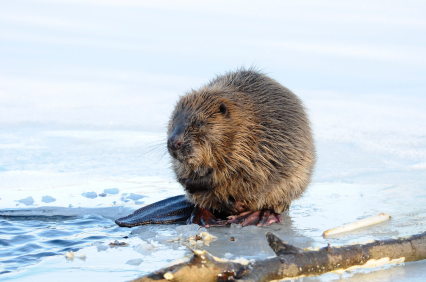Beavers do not hibernate in winter. The lodges they build for living, while mostly submerged, have a large dry room that is above water that serves as their den. This main room is insulated with sticks and mud, and it remains much warmer than the water or outside air. In addition, beavers build strong family ties. They mate for life, and they have one set of babies in the lodge, as well as the prior generation of babies called yearlings. All together in the den, their body heat keeps them warm enough to survive the cold season.
Beavers in Winter
Although beavers remain active in winter, they do adapt to this cold season in several important ways:
- They build a cache of food. Beavers are herbivores and live on a diet of woody tree bark and soft vegetation, including fruit, grasses, watercress, and water lilies. Cambium, the softer tissue under the bark, is also part of their diet. During summer and fall, beavers build a cache of food on land nearby that they bring into the lodge. They even create a “food shelf” inside their lodge for small supplies of food, so they don’t need to go out for food as often.
- Summertime overeating is a survival mechanism. Beavers take full advantage of the plentiful food of summer and fall to overeat to build up fat for winter. Beavers store about 40 to 60 percent of this extra fat in their tails as an emergency supply.
- They are not as active. Beavers slow down a bit during winter months to help save energy and preserve their fat reserves.
- Their fur coat is effective insulation. A beaver’s fur coat can both stop the cold from getting in and body heat from getting out because it is made up of two layers. Their upper fur is long and designed to be waterproof. This upper layer grows longer and thicker for winter. The second layer is an underfur. It is finer, and its oiliness helps keep water away from their skin. This second layer also provides extra insulation and keeps the beaver’s body heat in.
When Are Beavers a Nuisance?
Beavers are not wildlife nuisances in the traditional sense. They do not enter homes, create dens under porches, or cause house damage. Beavers are most often a nuisance in rural and farm areas where their dams can cause unwanted flooding and erosion caused by the destruction of trees whose roots hold the earth in place. They have also been known to cut corn stalks for food and as a building material for their lodge. Critter Control is prepared to help you solve any problem that arises due to beavers.
Beaver Behavior
Beavers are the largest rodents in North America. Known for their ability to take down trees with their teeth to build watertight dams, they are busy and hard-working mammals. The dams they build help reduce stream erosion and create habitats for many other animal species.
Beavers live throughout the country, with the exception of the deserts of California and Nevada, as well as parts of Utah and Arizona. Their natural habitat includes ponds, lakes, rivers, streams, marshes, and wetlands that surround these bodies of water.
Beavers are unusual and curious creatures in several ways:
- Like all rodents, a beaver’s teeth grow throughout their lives. Chomping down trees helps keep their teeth sharp and manageable.
- Beavers regularly go from aquatic to terrestrial environments. Even though their hind feet are webbed, their front feet are built for digging and carrying sticks on land.
- The broad, flat shape of their tail is one of their best-known features. But most people don’t realize that it is almost hairless and covered with scales. These tails have several uses: they help steer them underwater, provide balance for when they are on land, and can be slapped on the water to signal danger.
- They have oversized lungs that allow them to stay underwater for up to 15 minutes.
- Aside from man, they are the only animal to significantly alter their habitat.
